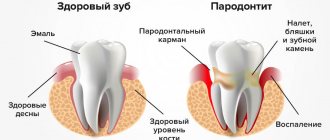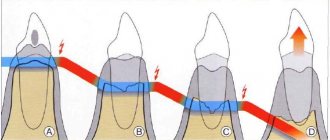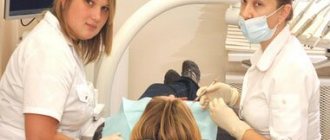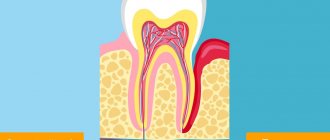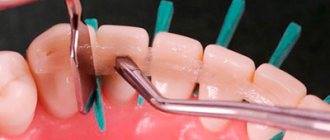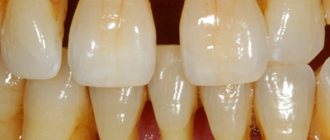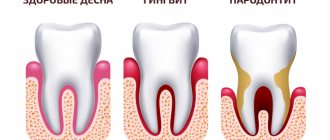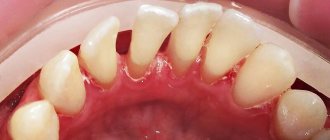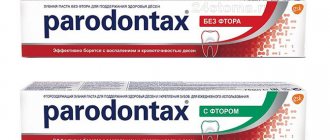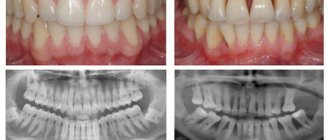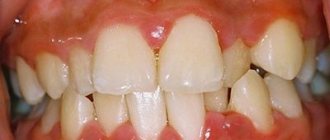General, or generalized periodontitis, is the process of inflammation that destroys the soft tissue of the periodontium throughout the oral cavity with damage to the teeth. The progression of the disease leads to atrophy or destruction of the bone and periodontal tissues that hold the tooth in the socket, and the formation of periodontal pockets (voids at the site of attachment of the gums to the tooth root). This contributes to infection of periodontal tissues, mobility and tooth loss. Most often, generalized periodontitis is chronic in nature with different periods of remission.
Generalized periodontitis: symptoms and treatment
Periodontitis is a very common pathology of periodontal tissues (soft tissue structures around the dental unit).
If the pathological process is started and left without treatment, then you can lose all the dental units. Periodontal pockets are the best location for the emergence and development of an infectious process, which does not have the best effect on the healthy state of the body. A beautiful and healthy smile gives you self-confidence and makes you feel natural. When periodontal tissue is damaged, the gums become red and swollen. The disease affects the overall health of the body and the well-being of a person. If something bothers you in the oral cavity, you should immediately consult a specialist. Dentist therapists at the branches of the West Dental family clinic in Yanino-1 and Vsevolozhsk will help with identifying the origins of anxiety and their treatment.
It has been scientifically determined that the occurrence of periodontitis is influenced by: soft plaque and hard deposits; filling material or orthopedic structure fixed in violation of treatment protocols.
What is periodontium
We all know that everything in our body is interconnected, each organ fulfills its mission, relying on the support of other organs and systems. For example, our teeth are surrounded by tissues that provide support and nutrition. These tissues are called periodontium. The periodontium includes
- jaw bones,
- ligaments that hold each tooth root in the bone socket,
- gum, inside which there are many vessels and nerve endings.
There is a certain relationship between teeth and periodontal tissues. The state of periodontal health depends on the following factors:
- integrity of the dentition;
- the position of the teeth within each dental arch and the uniform load on the teeth of the anterior and lateral groups;
- level of oral hygiene;
- hereditary factor.
Classification
According to the number of units affected by pathology:
- Catarrhal (localized) – 1-3 units in the affected area;
- Generalized – the entire dentition is affected.
According to the severity of generalized periodontitis (ICD code K05):
- Generalized mild periodontitis (ICD 10 code K05.3). This clinical diagnosis is made when the depth of the pockets in the gingival tissue is less than 3.5 mm, and less than 1/3 of the root is resorbed.
- Average. The subgingival depressions are 3.5-5 mm, and the bone is sclerosed at 50% of the root length.
- Severe degree. This stage is indicated by the depth of periodontal changes greater than 5 mm and resorption of more than 1/2 of the root.
Differential diagnosis according to pathogenesis:
- acute - more than one annual exacerbation;
- chronic generalized periodontitis (according to ICD K05) is an ongoing pathological process;
- exacerbation of chronic periodontitis – pain, discomfort, activation of the inflammatory process.
In recent years, dentistry has been enriched with a number of methodological approaches to providing quality care. Innovative dental materials, orthopedic structures and technologies for their manufacture have been developed, validated and put into practice, which has made it possible to increase the effectiveness of orthopedic treatment of patients with pathology of the dentofacial system.
The creation of new treatment regimens will make it possible to carry out treatment using an individually developed method, taking into account the pathogenetic links of various conditions of the oral cavity.
The basics of orthopedic treatment of dentition defects are as follows:
- Remove excess load from individual teeth or groups of teeth.
- It is rational to redistribute the chewing load between the remaining teeth, since a violation of the intensity of the functional load affects the metabolic process in periodontal tissues.
- Restore the functional unity of the dentition, connect individual groups of teeth into an integral system.
- Recreate a state of relative rest of the damaged periodontium and eliminate the pathological mobility of the remaining teeth.
- Carry out medical correction of chronic inflammatory-dystrophic processes in periodontal tissues.
- To provide an adequate assessment of the general condition of patients, which will significantly increase the effectiveness of treatment and quality of life.
In the complex therapy of generalized periodontitis, surgical treatment plays a key role. In most cases, only surgical intervention can lead to permanent elimination of the source of inflammation in periodontal tissues and help stop destructive processes in the bone.
Surgical and other methods of treating HP (drug, orthopedic, physiotherapeutic) should not be competing or mutually exclusive. They should be considered as complementary components of complex therapy.
Surgical preparation before treatment of dental defects
The choice of surgical method depends on the condition of the gingival margin and bone tissue of the alveolar process, the depth of the periodontal pockets, the degree of tooth mobility, assessment of the bite and the general condition of the patient.
It is possible to increase the effectiveness of the surgical stage of treatment of generalized periodontitis using neodymium and erbium lasers, taking into account the influence of these lasers on the number and nature of the microflora in periodontal pockets.
Bone defects are filled with osteoplastic materials, covered with a membrane, and sutures are applied. The use of a laser makes it possible to achieve more pronounced treatment results and sustainable stabilization of the process.
The widespread use of laser technologies in periodontal surgery can increase the effectiveness of treatment of patients with generalized periodontitis and will contribute to the preservation of natural teeth and their functional state.
In 1990, a work was published abroad in which tricalcium phosphate was named the best material for replacing bone tissue defects in children, and in 1997, at the international congress of implantology in Germany, hydroxylapatite was recognized as “the best medical material of all time.”
Without calcium phosphate materials, which demonstrate excellent performance in replacing bone defects, it is no longer possible to imagine modern orthopedics, spine surgery, dentistry and maxillofacial surgery.
The most commonly used calcium phosphate osteoplastic materials are:
- β-tricalium phosphate (β-TCP, Ca3(PO4)2)
- Hydroxylapatite (HAP, Ca10(PO4)6(OH)2)
- Biphasic calcium phosphate (BCP, a mixture of β-TCP and HAP)
- Deproteinized bone (eg bovine xenograft)
- Various combinations of hydroxyapatite with collagen, etc.
Calcium phosphate osteoplastic materials fill lost bone tissue, are characterized by almost ideal biocompatibility, safety for the body, and have the ability to optimize reparative osteogenesis due to osteoconductive, osteostimulating, and secondary osteoinductive properties.
The addition of an antibiotic to some implants allows them to provide antibacterial and anti-inflammatory effects at the implantation site.
The different rates of resorption and the different severity of the effect of calcium phosphate osteoplastic materials on reparative osteogenesis should be taken into account when using them in each specific clinical situation.
To restore defects of the alveolar process and fill missing bone tissues of the jaws, osteotropic bioceramics are increasingly being used, which have quite advantages over auto- or allogeneic bone grafts.
Synthetic biomaterials in surgery are most often used in granules, as this allows the elimination of bone defects of any form.
Thanks to the gradual resorption of osteotropic ceramics, the bone cavity is freed from the implanted material and filled with newly formed bone.
When hydroxyapatite is absorbed in the lesion, calcium and phosphorus ions are released, which stimulates the processes of bone tissue regeneration and makes the ceramics bioactive.
As a result of the studies, it was established that, depending on the combination of osteotropic bioceramics and a certain type of membrane, these materials can be used both to form the edge or thicken the alveolar process of the jaws, and to fill bone cavities after removal of hilar granulomas and cysts.
The enterprise LLC "Conectbiopharm" together with the State Institution of Central Asia named after N.N. Priorov, a number of new generation composite biomaterials based on bone xenocollagens, glycosaminoglycans and hydroxyapatite (Biomatrix, Osteomatrix) were developed and introduced into clinical practice.
These osteoplastic materials have begun to be widely used in modern dentistry. Patients with periodontal diseases undergo complex treatment at the stages of preparation for dental implantation, and after a thorough examination and preoperative preparation, surgical treatment using osteoplastic materials.
Restoration of bone tissue of the periodontal complex continues to be one of the most pressing tasks of periodontal surgery.
The arsenal of materials and methods of surgical treatment of inflammatory-dystrophic periodontal diseases is quite wide and varied.
More than 20 years ago, the attention of specialists was attracted by the fact of the growth of destroyed periodontal tissues in the space created with the help of separating membranes.
Thanks to research in the early 80s of the 20th century, carried out by the working group of Nyman and Lindhe, the method was called “directed regeneration of periodontal tissue.” Of particular interest were materials that can be bioresorbed and do not require repeated intervention to remove them.
Specific criteria for a membrane barrier have been formulated in the literature.
The use of the method of directed tissue regeneration using the Biomatrix collagen membrane and osteoplastic chips allows one to obtain positive clinical and radiological results.
The principle of targeted regeneration of periodontal bone tissue using a barrier membrane gives good results in both young and older patients. It should be noted that in young people, regenerative processes are more active.
The Biomatrix membrane is elastic, does not create difficulties at the stage of contouring according to the shape of the defect, and does not require additional fixation elements. This membrane can be used in three-, two- and single-walled defects, both in the area of separate teeth and in the case of an entire dentition.
Modern science today pays attention to membranes made of non-demineralized bone xenocollagen, which is saturated with sulfated glycosaminoglycans (sGAG).
Despite various modifications, periodontal surgical interventions alone do not create sufficient conditions for effective control of the pathological process and restoration of lost bone structures of the alveolar process.
Today, many researchers note the important role of changes in the bone tissue of the alveolar process in the pathogenesis of generalized periodontitis. The role of special agents influencing the course of reparative osteogenesis is increasing.
Most often in domestic practice, xenogeneic osteoplastic materials (hydroxyapatite, ß-tricalcium phosphate, collagen-containing materials) are used.
Drug correction of generalized periodontitis
One of the most significant achievements in periodontology was the discovery of the mechanisms of destruction of bone tissue of the alveolar process and the role in them of systemic disorders of the structural and functional state of skeletal bone tissue.
It has been established that a decrease in bone mineral density (BMD) of the skeleton is accompanied by the progression of dystrophic and resorptive processes in periodontal tissues, destruction of interdental bone septa, and inconsistency of bone remodeling processes.
The basis of the destructive processes of the alveolar process in patients with HP against the background of decreased BMD is increased bone resorption, which is not compensated by normal osteogenesis, which must be taken into account when carrying out therapeutic measures.
For the treatment of generalized periodontitis, osteotropic drugs are used, the action of which is aimed at activating the processes of reparative osteogenesis.
Numerous preparations of osteotropic action based on vitamins, organic substances and microelements (copper, zinc) have been proposed in Russia and abroad, which have antiresorptive, detoxification, antihypoxic, cytoprotective properties and stimulate the formation of bone tissue.
Preparations of this group can be used in preparation for orthopedic treatment of dentition defects, complex treatment of generalized periodontitis in order to normalize the biochemical parameters of the processes of reparative osteogenesis.
Currently, methods for complex treatment of generalized periodontitis in individuals with structural and functional disorders of bone tissue have been proposed.
However, there is still no data on the effectiveness and justification of surgical treatment in people with decreased BMD, especially with systemic osteoporosis.
Also, the influence of osteoplastic materials that are used to replace bone defects of the jaws on the metabolism of skeletal bone tissue as a whole has not been sufficiently studied.
Preparations based on soy isoflavones have a pronounced periodontal protective effect, normalize mineral metabolism and the condition of bone tissue, which have changed as a result of poor nutrition with a low calcium content and osteoplasty.
These data suggest the prospects and feasibility of using soy isoflavones to correct disorders of protein and mineral metabolism during the surgical treatment of HP in patients with structural and functional disorders of bone tissue.
Osteotropic and anti-inflammatory effects are characteristic of some drugs and dietary supplements. Among them, the “Biotrit-Denta” complex developed by NPA “Odessa Biotechnology” together with the Institute of Dentistry of the Academy of Medical Sciences of Ukraine.
The processes of bone restoration of the alveolar ridge, first of all, require the creation of favorable conditions for reossification. Reparative regeneration involves the restoration of bone tissue on a newly synthesized organic matrix with subsequent mineralization.
In this regard, osteotropic complexes are proposed to be supplemented with such systemic drugs as “Teraflex”, 1 capsule three times a day, and “Kalcemin”, 1 tablet twice a day. Taking medications is recommended throughout the entire treatment period, and then for stabilization of periodontal tissues for 2-3 months.
The use of osteotropic complexes ensures the creation of favorable conditions for the healing of bone wounds and improves the stabilization conditions in periodontal tissues, which contributes not only to the rapid recovery of the patient, but also allows him to create a positive attitude towards treatment and recovery.
The use of experimental osteotropic therapy based on biometals improves the supporting-mechanical function of the alveolar process by thickening it.
Hypomagnesemia is accompanied by exacerbation of chronic inflammatory processes, which manifest themselves in the form of activation of leukocytes and macrophages, release of proinflammatory cytokines and acute phase proteins, and production of free radicals.
Systemic preparations based on magnesium in a complex of therapeutic measures have a positive effect on key indicators of inflammatory-dystrophic processes in the periodontium, which is due to the anti-inflammatory effect of magnesium.
According to a number of authors, the introduction of the drug Miacalcic (calcitonin) into the complex of treatment of generalized periodontitis in patients in the acute stage of the disease normalizes the metabolism of bone tissue of the skeleton and alveolar process, inhibits the resorption of interdental bone septa, stimulates reossification processes, and promotes clinical stabilization of the pathological process in periodontal tissues.
Prevention of the inflammatory process in periodontal tissue at the stages of orthopedic treatment with fixed denture structures in patients before the start of treatment requires the use of additional methods of drug prevention of complications.
Local dosage forms based on the natural substance quercetin, as well as systemic preparations of glucosamine, zinc, calcium and vitamin D can be used as medications for the prevention of inflammatory complications.
Foreign studies on animals have shown that probiotics (“Symbiter Omega”) can prevent the depolymerization of collagen and non-collagen proteins in the connective tissue of periodontal tissue of rats under conditions of long-term administration of omeprazole.
Based on a biochemical study of the oral fluid of patients with chronic generalized periodontitis, the clinical effectiveness of the use of multiprobiotics has been proven. The use of probiotic preparations can increase the activity of the antioxidant enzymes superoxide dismutase (SOD).
The simultaneous use of SOD and glucosamine activators as anti-inflammatory drugs is justified, since these drugs realize their mechanism of action by affecting different parts of the pathogenesis of inflammatory diseases.
Optimizing blood microcirculation in periodontal tissues in the complex treatment of patients is an important step. An imbalance of endothelial substances precedes its damage (dysfunction) and the development of pathological conditions, which play an important role in the subsequent development of degenerative processes.
Improving microcirculation helps control degeneration. Therefore, a number of authors consider it pathogenetically appropriate to include the antihomotoxic drug “Lymphomyosot N” in traditional treatment regimens.
It has a complex lymphatic drainage, detoxification and immunomodulatory effect, which is realized due to its components of plant and mineral origin, tropic to the body's lymphatic system.
“Lymphomyosot N” has significant anti-inflammatory, anti-exudative and homeostatic properties, which gives grounds for many doctors in different fields of medicine to consider it the “gold standard” of anti-inflammatory therapy.
The complex use of Lymphomyosot N is a promising approach to prevent the progression of inflammatory-dystrophic processes in the oral cavity. The high efficiency of the proposed scheme in the complex treatment of periodontal tissues is explained by a wide spectrum of effects on all stages of pathogenesis.
In the treatment of initial inflammatory lesions of the periodontium (chronic catarrhal gingivitis and air-moderate periodontitis), due to the need to normalize metabolic processes and hemodynamics in the soft and bone structures of the periodontium, the drug “Actovegin” is used in the form of applications.
Surgical preparation for orthopedic treatment of dentition defects in GP is characterized by such problems as combating pain and inflammation. Therefore, there is a justified need for the use of non-steroidal anti-inflammatory drugs (NSAIDs).
Among the safest NSAIDs, incense tree extracts (Boswellia serrata) attract considerable attention, the mechanism of action of which is realized mainly by inhibiting the synthesis of leukotrienes. They accelerate reparative processes in the periodontium.
The administration of non-steroidal anti-inflammatory drugs based on ketorolac and nimesulide in the complex treatment of patients with generalized periodontitis who have undergone osteoplastic surgery provides a longer-lasting anti-inflammatory effect and a pronounced analgesic effect.
The search for new drugs - periodontal protectors with a complex effect on various parts of the pathological process in periodontal tissues - remains relevant.
In the complex therapy of diseases whose pathogenesis involves activation of FRO (free radical oxidation), antioxidants are increasingly used.
Antioxidants are substances of natural or synthetic origin that not only interact with lipid radicals (“direct” antioxidants), but also inhibit FRO by affecting one or more parts of the systems for the formation of reactive oxygen species, and reactivate antioxidant enzymes.
The modern arsenal of antioxidant agents is quite large and is constantly being replenished with new drugs that differ from each other in their mechanism of action, on the basis of which an attempt has been made to systematize this group of drugs.
In this regard, of particular interest are preparations based on bioflavonoids with a variety of biological functions, including pronounced antioxidant, anti-inflammatory, osteotropic activity, and so on.
These products include the aforementioned Biotrit-Denta - hygienic tablets for resorption in the oral cavity, created on the basis of an adaptogen from wheat germ. The product contains components to enhance the mineralization of bone tissue - calcium gluconate, sodium fluoride, lecithin (a source of phosphorus), ascorbic and citric acids, as well as the antiseptic decamethoxin, which has high antimicrobial activity against periodontopathogenic microflora of the oral cavity.
Based on the positive results of the use of bioresorbable synthetic materials for fixation of fractures in maxillofacial and orthopedic surgery, a hypothesis has been formulated that the production of a root analogue directly at the patient’s chair and its immediate implantation into the tooth socket after removal helps to preserve the shape and size of the alveolar process.
Rootreplica is a completely new, unusual technique developed by the Swiss company DS Degradation Solution, which is coming to dentistry today. The technique consists of making an exact copy of the removed tooth root, which is inserted into the socket within 5-7 minutes to prevent atrophy of the alveolar process after tooth extraction and restore hard tissue defects after surgical interventions.
However, it is worth returning to the issue of drug correction and mentioning the high clinical effectiveness of the osteotropic drug “Osteogenon”: with 30-day use, the frequency of postoperative complications is reduced by three times; in osteoporosis, the drug accelerates the consolidation of fractures.
"Osteogenon" is an ossein-hydroxyapatite complex that can compensate for nutrient calcium deficiency and provide the body with regulatory peptides.
Judging by the data obtained, Osteogenon has a modulating effect on calcium metabolism if the initial calcium level was equal to or below 2.0 mol/l. That is, “Osteogenon” corrects, first of all, the deficiency of the mineral in the diet. In individuals with serum calcium levels greater than 2.0 mol/l, no effect is detected.
Clinical effectiveness, along with the physiological nature of the action of Osteogenon on phosphorus-calcium metabolism and metabolic processes in bone tissue, justifies the feasibility of its use in dental surgery.
There is evidence of combined treatment with Osteogenon with ginkgo biloba extracts in standard doses for 1-2 months. This complex contributed to the improvement of all periodontal indicators.
The dietary supplement "Osteo Plus" includes vitamins B6 and B12, which provide the basis for collagen restoration, as well as medicinal plants - horsetail, papaya, parsley, pineapple, valerian root, licorice root.
According to a number of authors, this dietary supplement increases the functionality of the central nervous system and improves neuromuscular conduction, providing increased performance of the musculoskeletal system.
The condition of the bone tissue of the alveolar process, as the basis of the prosthetic bed, contributes to the formation of inadequate biomechanical loads after orthopedic treatment of patients with dentition defects.
In addition, orthopedic treatment is a stressful situation for the patient and leads to changes in metabolic processes in the tissues of the prosthetic bed. Biochemical changes are characterized by disturbances in the antioxidant system, which is accompanied by increased lipid peroxidation in the oral cavity in people using dentures.
Today, a close connection has been established between the state of the periodontium and the body’s antioxidant system, but the features of redox processes in patients with various types of orthopedic structures remain unclear.
Drug correction in preparation for orthopedic treatment of dental defects with metal-ceramic bridge structures is carried out using local anti-inflammatory and antimicrobial drugs.
In this regard, good results were demonstrated by rinsing with Givalex solution, as well as applications and instillations of Metrogil-Denta gel into periodontal pockets.
General recommendations
In conditions of dentition defects due to periodontopathy, permanent orthopedic treatment is preceded by splinting of each group of teeth using non-removable solid structures with aesthetic veneering.
Planning the restoration of dentition in patients with periodontal diseases requires the use of methods for determining the endurance of periodontal tissues of supporting teeth, their ability to withstand the functional load under the influence of dentures.
It is also necessary to take into account the degree of damage to periodontal tissues, the size and topography of dentition defects, the condition of marginal periodontal tissues and the general health of patients, lifestyle and concomitant diseases, which can significantly influence the choice of treatment tactics.
The effectiveness of orthopedic interventions and a sustainable effect in the complex treatment of periodontal diseases are ensured by appropriately carried out splinting and replacement of dentition defects, taking into account the compensatory capabilities of the periodontium.
Treatment should be aimed at normalizing the functions of periodontal tissues through the rational distribution of the functional load, equalizing the occlusal load on the teeth, dentition and TMJ.
Symptoms
The initial symptoms of the inflammatory process in periodontal tissues are the following:
- swelling of the gum tissue;
- severe bleeding during and after cleaning;
- throbbing severe pain.
As the pathology spreads, symptoms intensify:
- enlarged and painful lymph nodes;
- unpleasant odor from the mouth;
- mobility of dental units;
- increased sensitivity of tooth enamel;
- pain when biting and chewing food;
- deterioration of the general condition of the body;
- purulent discharge from periodontal pockets.
Chronic generalized periodontitis (beyond exacerbation) is characterized by:
- reddish color of gum tissue;
- exposure of tooth roots;
- Bone resorption is visually determined on the Rg image.
Causes
Inflammation of periodontal tissues flows from the acute phase into the chronic phase if treatment is not started in time and the causes are not eliminated.
Most often, the trigger is insufficient care. Food debris and dental plaque are sources of pathogenic bacteria that cause irritation of soft tissues. A prolonged inflammatory process leads to the gum moving away from the tooth and forming a so-called periodontal pocket, where dirt and bacteria accumulate. They increase inflammation and tissue loss, causing a reduction in the volume of the gums and jawbone. As a result, the neck of the tooth is exposed, it loses stability, becomes loose and eventually falls out.
Additional risk factors contributing to the development of chronic periodontitis include:
- unbalanced diet, lack of vitamins and microelements
- lack of chewing load
- smoking
- taking medications that negatively affect the immune system: antibiotics, antidepressants, etc.
- violation of the bite and position of teeth in the mouth
- diabetes, gastritis, endocrine system disorders
Chronic generalized periodontitis
Chronic generalized periodontitis (according to ICD 10-K05) affects the soft tissue and bone structures of all or more dental units. The frequency of occurrence is 5 times higher than carious lesions and its possible complications. Also, a generalized process can most likely lead to complete edentia (lack of teeth). The long-term location of the infectious process in periodontal tissues, without proper treatment, negatively affects the body's immune defense and can contribute to the development of rheumatoid arthritis, heart disease, etc. Generalized periodontitis has a different etiology.
What is localized periodontitis?
Localized, or focal, periodontitis is an inflammation of the periodontal tissues surrounding the tooth. Unlike generalized periodontitis, localized periodontitis spreads locally - it affects only one or several adjacent teeth. And even with prolonged development, the disease does not affect the “neighbors”. The disease affects all age groups, regardless of gender, but people aged 30 to 50 years and adolescents are more likely to suffer.
Diagnostics
To determine the disease and its severity, various diagnostic methods are used. For generalized periodontitis, differential diagnosis includes an extensive consultation examination to draw up a medical history (formation plan):
- collection of complaints (mobility of units, discomfort when chewing, periodic sharp pain in the attached gum);
- visual and instrumental examination (gingival pockets, recession of gingival tissue, dental plaque, reddish gums);
- determination of the color, shape and structure of gum tissue;
- finding out what condition the dental units are in: percussion, palpation, degree of mobility;
- determination of hygiene indices;
- RG images.
Sometimes, a specialist may prescribe a blood test to clarify the etiology.
Diagnostic measures should take into account not only all the symptoms of the pathology and the patient’s complaints, but also the mandatory performance of an X-ray. Basically, in case of periodontitis, it is recommended to perform an OPTG (orthopantomogram) - a panoramic image. In such an extensive image, all dental structures and the degree of bone damage in each unit are immediately visible.
Causes of localized periodontitis
There are common factors that provoke periodontitis of any form:
- crowded teeth, malocclusion
- infectious diseases of the oral cavity, such as stomatitis
- advanced caries
- smoking
- poor oral hygiene
- vitamin deficiency, diabetes mellitus and gastrointestinal disorders
The causes of localized periodontitis that influence the development of this particular type of disease are: mechanical and chemical damage to the teeth and gums, incorrectly placed fillings, dentures; bruxism.
Mild degree
As usual, mild degrees are not given any importance. A subgingival pocket is formed near the dental unit, where microorganisms accumulate. There are signs of periodontal inflammation, and on the Rg image there is destruction of bone tissue by 1/3 of the root, gum pockets up to 3.5 mm. In the cervical area of the teeth, hard deposits are observed, the gums are loose, slightly inflamed and swollen. There is slight bleeding when cleaning, and discomfort when chewing solid food. Mobility and movement of teeth is not observed at this stage.
Features of the chronic course of the disease
The impetus for the development of chronic periodontitis can be gingivitis or other diseases of the oral cavity. Insufficient hygiene and neglect of treatment when the first signs of periodontal inflammation are detected are the most common causes of the development of the chronic form. It has two stages:
- An exacerbation in which constant throbbing pain, bleeding, and pus discharge are observed in the gums; abscesses form, pathological tooth mobility increases, body temperature rises, and the submandibular lymph nodes become inflamed. This often occurs against the background of acute respiratory viral infections, pneumonia, stress and other factors.
- Remission, which occurs after treatment. During this period, the main symptoms of the disease are absent and the patient does not experience severe discomfort.
Average degree
With moderate severity, periodontal pockets up to 5 mm are observed. The x-ray shows damage to the bone septa on half the root. In the oral cavity, upon examination, there is a sufficient number of dental deposits, mobility of teeth I-II degrees, inflammation of the gums. A small amount of pus may ooze from under the gums. When the process worsens, slight mobility and displacement of units occurs.
Patients complain of pain in the gums; pain and bleeding when eating; the necks of the teeth are exposed; a reaction to cold and hot food is formed.
Symptoms of chronic periodontitis:
But in almost all cases, patients turn to the periodontist precisely with chronic generalized inflammation of the gums, and the medical history is always the same. First, insufficient oral hygiene leads to the accumulation of microbial plaque on the teeth, pathogenic bacteria in which produce “toxins” that trigger inflammation in the gums. At first, the inflammation is only superficial in nature, and is manifested by bleeding and pain when brushing teeth, as well as swelling, redness or cyanosis of the gingival margin.
At this stage, there is still no destruction of the periodontal attachment, destruction of bone tissue or destruction of periodontal fibers, due to which the tooth is attached to the bone tissue. This inflammation of the gums is called catarrhal gingivitis. If it is treated incorrectly or untreated, gingivitis sooner or later transforms into the next form of gum inflammation, i.e. in periodontitis. The starting point for the development of periodontitis is the destruction of the dentogingival attachment (i.e., the attachment of soft gum tissue to the neck of the teeth).
The dentogingival (enamel) attachment is an anatomical barrier that prevents the penetration of pathogenic bacteria below the gum level. As soon as this barrier is destroyed, inflammation affects not only the soft gum tissue, but also bone tissue, as well as periodontal fibers, due to which the tooth root is attached to the bone tissue. This leads to their gradual destruction. Symptoms and treatment of periodontitis will depend on its severity (i.e., the degree of destruction of the tissue around the teeth). There are mild, moderate and severe forms of this disease.
Mild periodontitis –
With a mild form of periodontitis, firstly, all the symptoms of catarrhal gingivitis will persist, i.e. the patient will continue to complain of occasional pain and bleeding when brushing teeth. In addition, swelling, bluishness or redness of the gingival margin will continue to be observed, as well as accumulations of microbial plaque or tartar in the area of the necks of the teeth (Fig. 4-5).
What periodontitis looks like: photo
The main diagnostic criterion that distinguishes the symptoms of the initial stage of periodontitis from the symptoms of catarrhal gingivitis is the formation of periodontal pockets (gingival pockets) - up to 3.5 mm deep. Such pockets are formed due to the destruction of the attachment of soft gum tissue to the necks of the teeth, which leads to the penetration of pathogenic bacteria below the gum level. As soon as this happens, inflammation and pathogenic bacteria lead to the destruction of periodontal tissue and bone tissue near the tooth root (Fig. 6).
On the surface of the tooth root (in the depths of the periodontal pocket) there are hard dental deposits, and the lumen of the pocket is filled with serous-purulent discharge. During a period of decreased immunity, the patient may notice that purulent discharge may be released from the periodontal pockets - this becomes especially noticeable when pressing on the gums in the projection of the periodontal pocket. In patients with this stage of periodontitis, a panoramic radiograph shows a decrease in the level of bone tissue (interdental septa) - up to 1/3 of the length of the roots of the teeth, and there may be 2 types of inflammatory bone resorption:
- Horizontal bone resorption is typical for elderly and relatively elderly people; the disease usually progresses slowly (with a uniform decrease in the height of bone tissue in the area of all teeth). Thus, in this group of patients, periodontal pockets with a depth of 3.0-3.5 mm may sometimes not be visible, but there is a uniform decrease in bone level in the area of all teeth.
- Vertical bone resorption is typical for young and relatively young people. The nature of the inflammation is usually aggressive (with rapid progression). Bone destruction occurs only in the area of periodontal pockets that form along the surfaces of the roots of the teeth. At the same time, as such, a decrease in the height of the interdental bone septa is not observed. This form is the most difficult to treat.
Important: with mild periodontitis, tooth mobility is not yet observed, as well as their displacement under the influence of chewing pressure (all this is typical for moderate and especially severe periodontitis).
Moderate periodontitis –
This stage of the inflammatory process is distinguished by the fact that the number of periodontal pockets increases significantly, and their depth can already reach 5.0 mm. An increase in the depth of the pockets creates excellent conditions for the proliferation of pathogenic pyogenic bacteria, and therefore the release of serous-purulent exudate from the pockets becomes rather the norm (which is especially visible when pressing on the gums in the projection of the periodontal pocket). In addition to pathogenic bacteria, periodontal pockets at this stage may also contain fungal flora, which is important in the choice of drugs for the treatment of periodontitis.
An increase in the depth of periodontal pockets to 5.0 mm means a decrease in bone level by approximately 1/3-1/2 of the length of the roots. Visually, this can be expressed in a decrease in the gingival margin relative to the necks of the teeth, i.e. Root exposure may already be occurring. In addition, with such a degree of bone destruction, 1) mobility of teeth of 1-2 degrees occurs, 2) tilting of some teeth may appear, 3) fan-shaped discrepancy of the front teeth may begin to appear. The latter is especially typical for patients with the absence of a large number of lateral chewing teeth.
Moderate periodontitis –
At this stage of inflammation, patients often complain of a deterioration in their general condition - increased fatigue, weakness, and a decrease in immunity + frequent colds. This is due to the fact that serous-purulent discharge is always present in periodontal pockets, from which toxins and pathogens are absorbed into the blood and spread throughout the body, affecting primarily the immune system.
Very important: once again we draw your attention to the fact that at this stage of periodontitis, “secondary deformations of the dentition” already occur, i.e. the teeth begin to “move apart” (changing their position depending on the direction of the usual chewing pressure). Therefore, the treatment of moderate periodontitis is already much more complex - in comparison with mild periodontitis, and will require you to spend quite a lot of money on splinting and prosthetic teeth. Therefore, it is important not to bring it to such a state, and not to self-medicate (24stoma.ru).
Severe periodontitis -
Severe periodontitis is characterized by further deterioration of all symptoms. The depth of periodontal pockets can already reach 6.0 or more. Accordingly, the decrease in the level of bone tissue in the area of the interdental septa reaches 2/3 or more of the root length. Mobility is observed in most teeth, and in some teeth it already reaches 3-4 degrees. With this severity of periodontitis, exacerbations of the inflammatory process often occur, which are accompanied by the formation of abscesses, sharp swelling of the gums, pain in them, and a sharp increase in tooth mobility.
Severe periodontitis: photo
It should be noted that in severe cases, patients begin to suffer not only from local symptoms in the oral cavity, but also complain of weakness, malaise, poor sleep, and appetite. Severe chronic inflammation of the gums can also affect the frequency of exacerbations of chronic diseases of the internal organs. The condition of patients with diabetes mellitus, cardiovascular, hormonal, and rheumatoid diseases is especially deteriorating.
Exacerbation of periodontitis – there is also such a thing as “course of the disease”. As a rule, periodontitis is characterized by a sluggish chronic course, i.e. when the symptoms are smoothed out (there are no acute phenomena of inflammation), but exacerbations of the inflammatory process may periodically occur. During exacerbations, the symptoms become much more pronounced - tooth mobility and bleeding gums increase, swelling of the gums and the formation of purulent abscesses may occur, and purulent discharge from periodontal pockets may also appear. The development of exacerbation may be associated both with the depletion of local protective mechanisms of the oral cavity and with a decrease in the body's immunity. Next, we will talk about how to treat periodontitis.
Severe degree
Chronic generalized severe periodontitis, as diagnosed, is determined by deep periodontal pockets over 5 mm and 2/3 of the tooth root being exposed. With this degree of pathology, great swelling, bleeding and hyperemia of the gums occurs, and eating is quite painful. In periodontal pockets there is a large accumulation of pus and microorganisms in the form of dental deposits. Patients have complaints of pain, itching, burning and pulsation in the gums. It is impossible to carry out high-quality hygienic cleaning on your own; a persistent unpleasant odor persists for a long time. In the absence of proper therapy, severe suppuration and mobility of grade III-IV units are observed, up to prolapse. Complications may develop in the form of abscess formation of foci of infection and periodontal disease.
Also, this pathology is manifested by a violation of the general condition of the body. A person is worried about weakness, fever, and in connection with this, fatigue. Regional submandibular lymph nodes enlarge and become painful on palpation.
What to do to avoid complications
To avoid complications, it is necessary to recognize the disease in the early stages and take measures for adequate treatment. All this will allow you to achieve stable and long-term remission and preserve the functions of your teeth and gums. In order for the dental system to be healthy, it is necessary not only to observe the rules of personal hygiene, carrying out regular care procedures, but also to periodically visit a specialist who will perform professional cleaning in order to remove minor dental deposits.
General symptoms of the disease
In the initial stages, the patient suffers from severe bleeding gums. They become loose and swollen. The patient feels itching, throbbing, severe burning, pain when he chews food. An unpleasant odor begins to emanate from the mouth. Dental pockets at this stage are shallow, they are located mainly in the interdental spaces. At the initial stages, the teeth are motionless and not displaced anywhere. The patient's general condition is normal.
The clinical picture of the developing disease is somewhat different. In addition to the above symptoms, the patient may experience:
- displacement of teeth and their loosening;
- high sensitivity of teeth to external irritants (temperature fluctuations);
- problems chewing food;
- disturbance of general well-being (typical of severe forms of pathology), accompanied by weakness, malaise, and increased body temperature;
- an increase in the size of regional lymph nodes, which in addition become painful;
- during a dental examination, the doctor observes signs of diffuse gingivitis;
- Plaque and deposits accumulate abundantly on the teeth;
- tooth loss, fistula, abscesses (signs are characteristic of advanced stages of the disease).
In the case of a chronic form of the disease, the gums have a pale pink tint. There are no dental deposits, manifestations of pus or blood. There is a possibility of exposure of the roots of the teeth. X-ray does not show signs of bone resorption.
Treatment
When the pathological process has taken the form of chronic generalized periodontitis, it is more difficult to carry out effective treatment. It is important to address the underlying cause of the disease. In this regard, the generalized form of periodontitis requires consultation with dentists in related fields to identify the source of the pathology. The general dentist/periodontist can provide recommendations for consultation with an endocrinologist, hematologist, immunologist, etc. After general interaction and identification of the cause of periodontitis, the attending physician prescribes the necessary therapy.
Treatment of the pathological process consists of the following measures:
- Professional oral cleaning and hygiene training. A specialist removes soft and hard dental deposits, including those under the gums. The tooth enamel is polished with special brushes with paste and coated with a protective gel with fluoride. Oral care products are selected and instructions on their use are provided.
- Treatment of associated dental problems. To cure periodontitis, it is important to treat caries, pulp disease, and pathological processes in the gums and bones.
- Drug therapy. Oral baths with solutions, application ointments, NSAIDs and painkillers, and sometimes antimicrobial drugs are used.
- Removal of subgingival pockets by a dental surgeon. In case of moderate and severe severity, it is possible to perform open and closed curettage of pockets, as well as gum plastic surgery.
- Treatment using orthopedic structures. As part of complex measures, temporary splinting of mobile units is performed with an orthodontic retainer or fiberglass; selective grinding of the chewing surfaces of teeth; prosthetics of large dental defects to redistribute chewing pressure.
- Physiotherapeutic manipulations. Many physiotherapy procedures have a positive effect on recovery: UHF, infrared radiation, magnet and laser therapy, electrophoresis, direct and alternating current, vacuum and acupressure massage, paraffin therapy, mud therapy.
For effective treatment of pathology and the occurrence of remission of the process, it is important to fully comply with the specialist’s instructions.
Treatment methods
With periodontitis, the risk of losing a tooth or an entire row of teeth is high. It is important to detect and treat the disease in time. High-quality cleaning of gum pockets at home is impossible, so this hygiene step should be entrusted to a doctor. Conservative or surgical treatment can be supplemented with folk remedies. The goal of any method is to destroy the infection and restore tissue.
Complex therapy
The treatment regimen includes professional hygiene, the use of local and general medications, and physical therapy.
In dental clinics, the oral cavity is sanitized: tartar and deposits are removed, periodontal pockets are cleaned, and the cause of the disease is identified and eliminated. During sanitation, antiseptic agents are used: iodinol, chlorhexidine, furacillin, peroxide, which effectively clean and disinfect inflamed tissues.
To stop inflammatory processes and destroy pathogenic microflora, gel applications are made or medications are injected into the periodontal pocket. Hypertonic drugs help relieve swelling and inflammation, eliminate bacteria and their waste products - antibiotics and adsorbents. Enzyme preparations are used to normalize oxidative processes and break down necrotic tissue. To increase local immunity, immunostimulants are used.
In case of severe inflammation, it is advisable to use systemic drugs: antibiotics, histamines, immunomodulators, vitamin complexes, which include vitamins C, group B, E, K, PP. If the patient experiences anxiety or irritability, sedatives are used. The duration of the course of medication is determined by the doctor.
The treatment complex includes physiotherapy: phototherapy, ultrasound, UHF, aerosol therapy, electrophoresis, laser treatment and other procedures. Physiotherapeutic methods are aimed at normalizing metabolic processes, blood circulation, lymph circulation, eliminating inflammation, strengthening and restoring periodontal disease. The number of sessions depends on the severity of the problem.
To support basic therapy, you can rinse your mouth with herbal infusions: pine rinse, oak bark decoction, tincture of marsh calamus, lingonberry leaves.
Orthopedic treatment
It is used when a tooth is missing or it is impossible to save it (after preliminary removal). Dentures are necessary to prevent malocclusion, which can provoke further development of the disease. Medical procedures are performed by an orthopedic dentist.
Basal implantation shows high efficiency. The implants are easily placed in the deep part of the jawbone and have a smooth antimicrobial layer. Plaque does not accumulate on them, and the inflamed tissues are restored over time and the person recovers.
Surgery
Surgical intervention is required in advanced cases, if the problem cannot be eliminated by conservative methods. The surgeon performs flap operations, splinting teeth, and open curettage.
During flap operations, periodontal pockets and tartar are eliminated, the gum edge is corrected, and the volume of bone tissue is replenished (bone grafting). Splinting is done to fix a moving tooth in the correct position. Open curettage allows you to efficiently clean gum pockets more than 5 millimeters deep.
